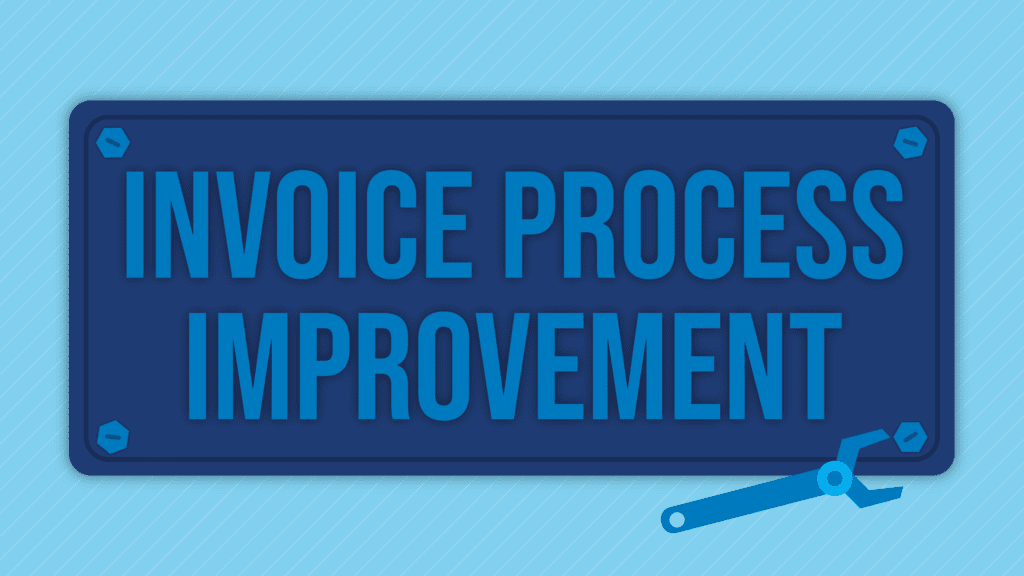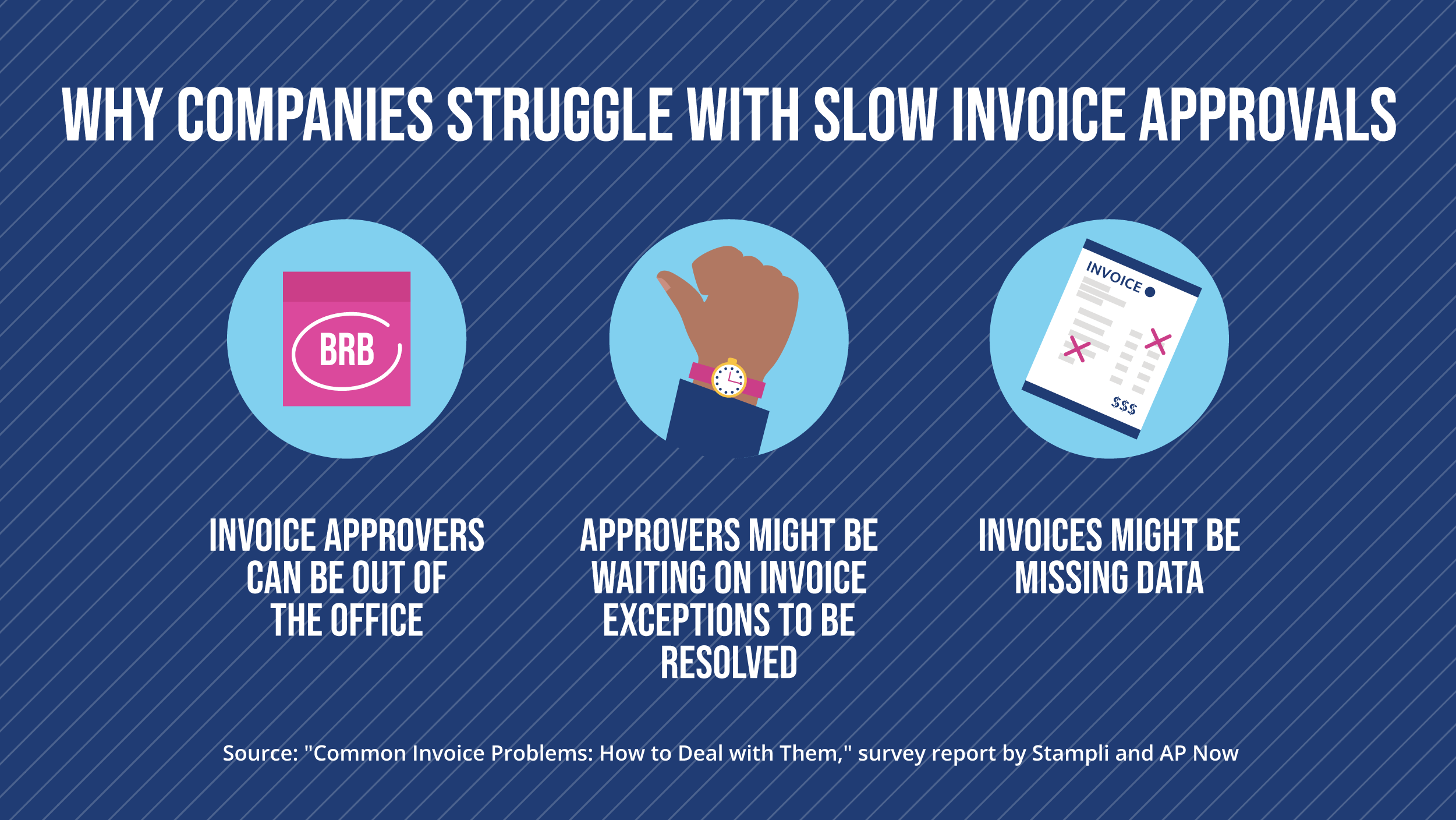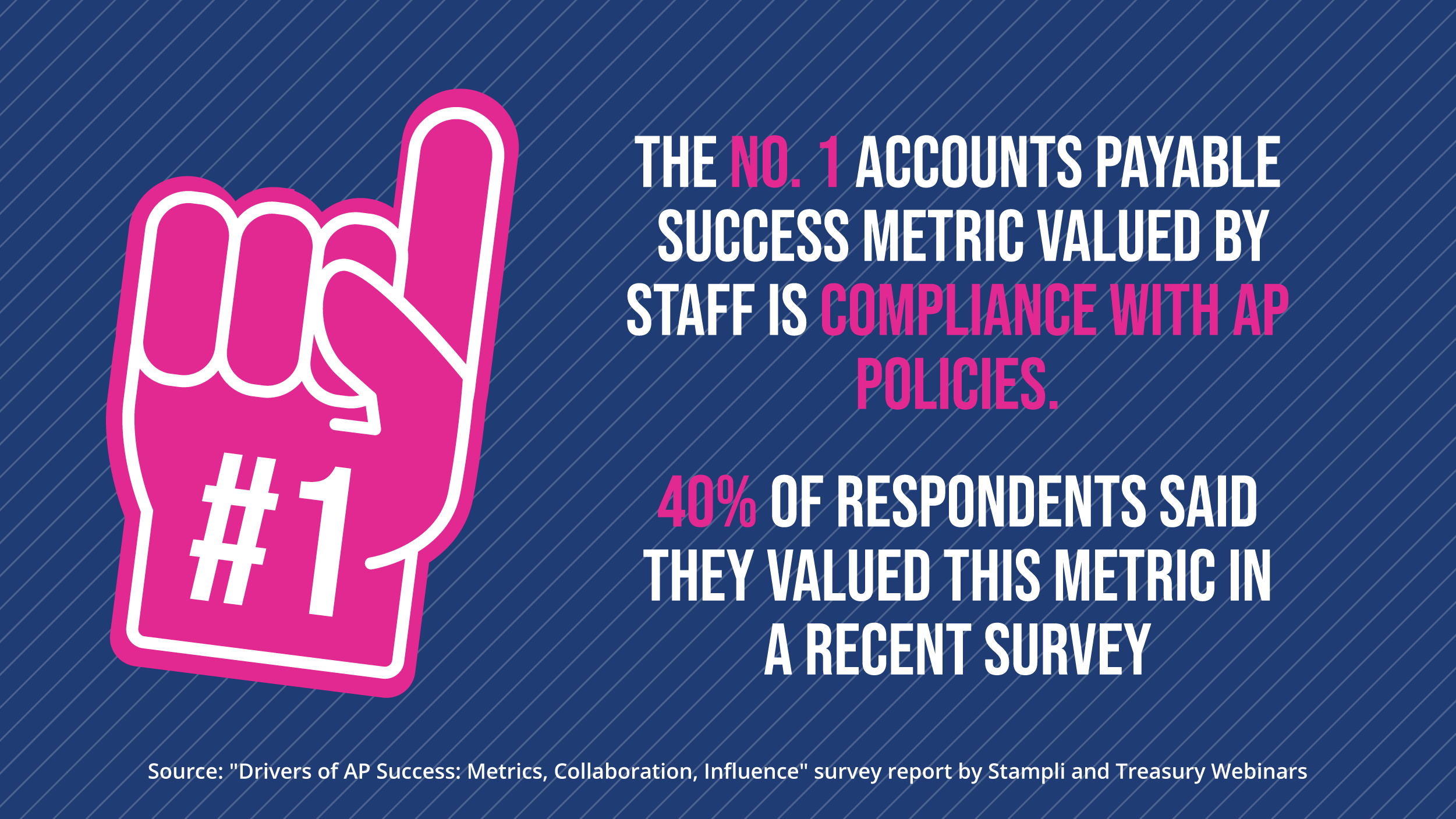Invoice Process Improvement: Fine-Tuning Your Company’s AP Operations

When it comes to accounts payable and invoice processing, there’s always room for improvement.
Perhaps your company struggles with late payments or days outstanding for invoices, two problems that have increased for businesses in recent years. And it’s long been clear that companies can experience a whole range of invoice-related issues, from missing data to snail’s pace approval rates.
Today, we’re going to offer a better path. Join us as we discuss invoice process improvement: a few basics of what it is; why accounts payable (AP) automation should factor in; and how Stampli can help companies thrive.
Invoice Process Improvement Basics
When we refer to invoice process improvement, we’re not just talking about whipping up slicker invoices for AP departments to send to vendors. Invoice process improvement can cover everything from when a company and vendor decide to do business to when an invoice is paid and reconciled.
Let’s look at a few basics of invoice process improvement.
Why Invoice Process Improvement Matters
The average company gets hundreds, if not thousands of invoices each month for everything from printer toner to break room coffee. A survey by Stampli and Treasury Webinars, “AP Today: Bottlenecks, Benchmarks & Best Practices” found just 8% of companies surveyed were getting under 100 invoices each month, with 54% getting over 500.
Without a solid invoice process improvement plan, serious AP backlogs can quickly start to ripple across companies.
Invoice process improvement helps keep operations running smoothly. It also helps at a tough time. PYMNTS.com noted in August 2021 that “as many as three-quarters of businesses with revenues between $25M and $100M said that late payments have been exacerbated due to the pandemic,” while 60% of small businesses had seen their days outstanding for invoices increase.
What Typically Holds Up the Invoice Process
To someone who’s never worked in accounts payable, the work might seem simplistic enough: get a bill, pay it, repeat. But invoice processing is far more complex and not surprisingly, many things can cause it to stall.

A survey report by Stampli and AP Now, “Common Invoice Problems: How to Deal with Them” quantified various invoice-related issues experienced by companies, such as:
- Slow internal approvals, experienced by 72% of respondents;
- Missing purchase order numbers or requisitioner names, experienced by 71%;
- Invoices sent to wrong people or places, experienced by 65%;
- Manual data entry required for the invoice, experienced by 50%;
- Duplicate invoice submission, experienced by 50%.
Even with smart and capable accounting staff, companies can lag and need invoice process improvement if they don’t have the right tools.
Strategies for Invoice Process Improvement
The first step in invoice process improvement is awareness, acknowledging that things could be running better. Rather than just simply flogging staff to try harder, a smarter solution is a combination of training, communication, workflow, and technological upgrades.
Companies can work to get everyone on the same page with what needs to happen when an invoice arrives. Executives, rank-and-file accounting staff, and even vendors can have shared understanding of precisely what should occur with each invoice, from when and how to match it with purchase orders and receipt reports to an acceptable number of days to get it queued for payment.
Too often, AP procedures might not be codified. Insisting on good communication and workflows helps counteract this, dictating the most logical methods for processing invoices. Companies can also take the opportunity to train staff in how to follow these workflows, with Stampli and Treasury Webinars’ survey report, “Drivers of AP Success: Metrics, Collaboration, Influence” finding that 47% of respondents were at companies offering formal training in-house.
Of course, training, communication, and crafting smarter workflows can only go so far. Next, we’re going to look at why AP automation software is needed for true invoice process improvement.
3 Reasons Invoice Process Improvement Needs AP Automation
Invoice process improvement can start to happen with better workflows, clearer lines of communication, and training. All the same, without implementing AP automation software, a company’s efforts might fall short.
Here are three reasons that invoice process improvement needs AP automation:
1. Quicker and Cheaper Processing
The simplest value proposition for AP automation is that it can help invoices get processed a whole lot faster and at a fraction of the expense of traditional methods.
How much time and money get saved? PYMNTS.com noted in September 2020 that through automation, companies could save as much as 80 percent. Stampli and Treasury Webinars also noted in its survey report, “The How, the Why & the ROI of AP Automation” that 36% of respondents already knew that automation was giving their companies lower AP processing costs overall.
The same report also found that 57% of respondents had determined that they were achieving faster approval of invoices. Trying to process invoices without automation can drag for weeks, even months, with Stampli and Treasury Webinars’ bottleneck report finding that small companies needed an average of 15 days, medium firms 17 days, and enterprise-level companies 20 days to pay an invoice in a manual paper-based process.
With automation, though, this time can be reduced to a matter of days, sometimes even hours.
2. Better Compliance and Records
In Stampli and Treasury Webinars’ AP success driver report, the No. 1 metric valued by staff, at 40% of respondents, was compliance with AP policies. Still, this isn’t always an easy guidepost to satisfy, particularly when a company is running late on a payment. Left unchecked, it can set companies up for all sorts of less-than-ideal outcomes.

Hand in hand with compliance, AP is sometimes the closest thing a company has to an archive, expected to maintain years of financial and accounting records. One of the major reasons invoice process improvement can lag? These records can get pretty spotty if they simply exist in paper form, with invoices, purchase orders, and receipt reports easily able to go missing.
Automation automatically connects invoices, POs, and other key documents in the system, letting companies know their records will be there when they need them.
3. Fewer Late Fees, More Discounts
Companies need every discount they can get. One vital source of savings can be early payment discounts that some vendors offer, such as a 1%/10 Net 30 discount which, as Investopedia notes, “means that if the bill is paid within 10 days, there is a 1% discount.”
Still, as helpful as early pay discounts can be, they often go uncollected, with 23% of respondents in Stampli and AP Now’s survey on invoice issues admitted they’d missed early payment discounts. Worse, companies can easily wind up letting a missed early discount be their gateway to paying the invoice late.
With automation, though, companies are much more likely to avoid penalty fees and to start racking up more discounts, which can help effectively lower the cost of AP automation.
How to Ensure Invoice Process Improvement with Stampli
Invoice process improvement doesn’t have to be a nebulous and uncertain effort. Stampli has created an AP automation solution that helps pave the way for maximum invoice process improvement.
Aside from offering standard benefits of AP automation highlighted above, here are a few areas Stampli particularly excels in.
Stampli: A SaaS-Based Solution that Works with Existing Systems
The olden days of accounts payable meant that companies either had to process invoices with pen and paper or spend untold sums to develop a proprietary, internal system.
In the past decade or so, a huge number of software-as-a-service, or SaaS-based options have hit the market, allowing many companies, particularly smaller ones, to leverage AP automation for the first time. But there’s been a hidden downside to the proliferation of SaaS-based options: some don’t work smoothly with every enterprise resource planning (ERP) platform.
Few things can cause invoice processing delays like AP automation and ERP software that’s not on speaking terms. Part of what makes Stampli great for invoice process improvement, though, is that the software is built to sync easily with all of the major ERP platforms on the market today. These integrations include Dealertrack DMS, Microsoft Dynamics 365 Finance, Microsoft Dynamics GP, Oracle NetSuite, QuickBooks Desktop, QuickBooks Online, Sage Intacct, and SAP.
Customizable Workflows to Keep Your Process Moving Smoothly
As noted earlier, establishing workflows can help invoices flow directly where they need to go in any given situation, ensuring that proper procedures are followed for each invoice management step and that whoever needs to see it does.
All the same, without AP automation, creating workflows might mean that they get typed out and that workers have to refer to a physical document whenever they’re supposed to follow them, potentially driving down adoption rates. And even with automation, some workflow software can be very tricky to use.
Stampli makes it easy, though, as each role is given an unique view that provides the relevant information needed to take action, whether that’s to process an invoice, approve an invoice, or authorize a payment. Stampli is also highly configurable to meet the unique needs of your organizational processes. Create custom fields to identify and track anything to support internal controls or specific company workflows.
AI and Machine Learning, via Billy the Bot, for Invoice Scanning and Matching
AP workers loathe few tasks like having to manually input invoice details. It’s time-consuming work that can get invoice processing off to a clunky start. It’s also pretty easy for human staff punching in an invoice to make data entry errors, assuring that data isn’t going to match with what’s in the ERP and that incorrect B2B payment amounts might get sent out.

At Stampli, invoice scanning is left to Billy the Bot, our artificial intelligence-powered assistant that uses intelligent OCR, AI and machine learning to glean invoice details. The machine learning also picks up vendor tendencies, helping processes go quicker in the future. In addition, Billy pulls in invoices and supporting documents for easy three-way matching capabilities, and can even resolve invoice exceptions when processes change.
It’s all part of how Stampli helps provide top-flight invoice process improvement. That’s because Stampli’s mission has always been to provide Controllers and their Accounts Payable team full control and visibility over all company spend, regardless of the payment method. At Stampli, we believe payment methods shouldn’t determine the process; AP determines the process.
If you’re interested in learning how Stampli provides control and flexibility when it comes to payments, check out Stampli Direct Pay, where you can issue paper check andautomated clearing house (ACH) payments to your vendors, or pay outside of Stampli. You get to choose and are always in full control with Stampli. Then when it comes to corporate credit card payments, you have the same payment freedom available with Stampli Card.
Invoice process improvement to keep your AP operations running optimally. Learn more about the Stampli advantage today.
